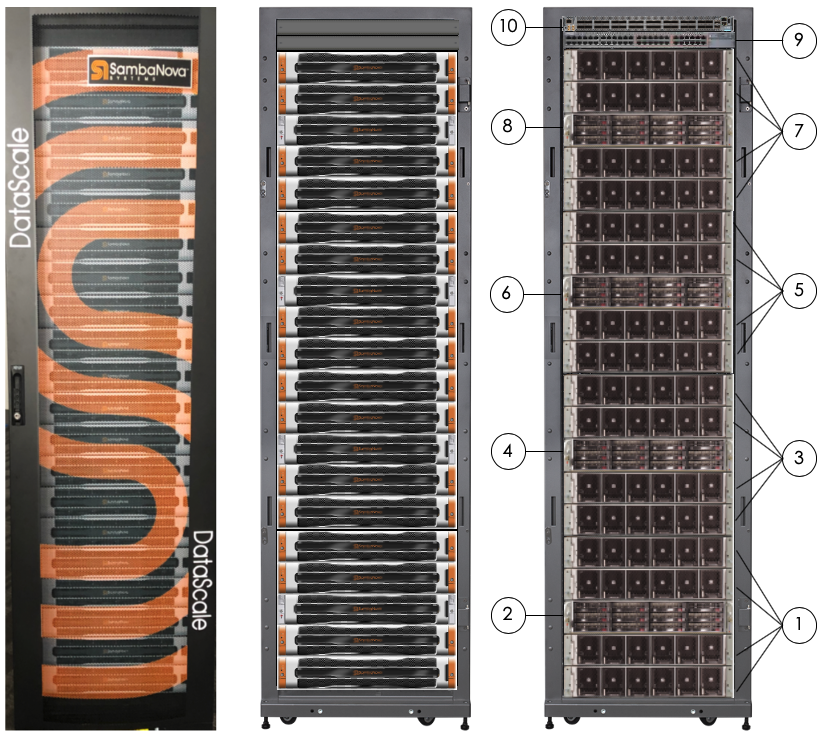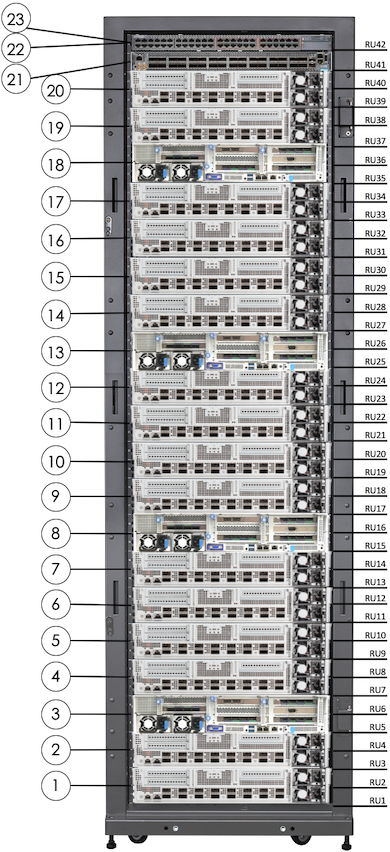Get started with DataScale rack administration
This SambaNova DataScale® hardware administration document targets the SN10 2PDU version of the SambaNova DataScale rack (also known as SN20).
This page gets you started:
-
Learn about SambaNova support, SambaNova documentation, and other resources.
-
Get an overview of the DataScale hardware and software stacks.
| See the DataScale hardware installation document for details on hardware installation requirements and tasks. There are minor difference for different versions, so ensure that you’re using the correct version of the document. |
1. SambaNova support
SambaNova customers that have valid support contracts can contact support and obtain product support documentation through the SambaNova support portal at https://support.sambanova.ai.
2. SambaNova documentation
As part of hardware installation, you might need SambaNova documentation, SambaNova KBs, and third-party documentation.
-
SambaNova product documentation: https://docs.sambanova.ai.
-
SambaNova knowledge base (KB) articles: https://support.sambanova.ai.
3. Overview of SambaNova DataScale SN10-8R hardware
The DataScale SN10-8R is self-contained in a standard 42 rack unit (RU) datacenter rack. System population begins at the bottom of the rack with system 1 and increments up the rack to system 2. Network switches and other equipment are installed at the top of the rack.
A DataScale SN10-8 system consists of the following:
-
Four DataScale SN10-2 reconfigurable data units (RDU) modules, also called XRDUs.
-
An x86 server DataScale SN10-H host module running either Red Hat® Enterprise Linux® or Ubuntu® Linux
Each of the four DataScale SN10-2 RDU modules contains two RDUs, for a total of eight RDUs per DataScale SN10-8 system. The RDUs are managed by the SambaNova SambaFlowTM software stack running on the DataScale SN10-H host module. The DataScale SN10-2 RDU modules and the DataScale SN10-H host module are 2RU chassis.
Switch equipment at the top of the rack provides a data network and an access network. Figure 1 and Table 1 identify the main components in the DataScale SN10-8R.

| No. | Component |
|---|---|
1 |
System 1 SN10-8 (four SN10-2 RDU modules) |
2 |
System 1 SN10-8 (one SN10-H host module) |
3 |
System 2 SN10-8 (four SN10-2 RDU modules) |
4 |
System 2 SN10-8 (one SN10-H host module) |
5 |
System 3 SN10-8 (four SN10-2 RDU modules) |
6 |
System 3 SN10-8 (one SN10-H host module) |
7 |
System 4 SN10-8 (four SN10-2 RDU modules) |
8 |
System 4 SN10-8 (one SN10-H host module) |
9 |
Juniper® QFX5200-32c Ethernet (fan-side) |
10 |
Lantronix® serial console server (Juniper EX4300 behind) |
SambaNova delivers the DataScale SN10-8R internal components preconfigured and cabled in the 42RU rack. This section identifies what is cabled internally.
| You are not expected to interact with the internal cabling of the DataScale SN10-8R. You have to interact only with cables for the network and power components. You connect those cables to provide power and network connectivity to the DataScale SN10-8R. See the SN10 version of the DataScale SN10-8R hardware installation documentation. |

| No. | Component Description |
|---|---|
1 |
SN10-H-1-XRDU0 (system 1) |
2 |
SN10-H-1-XRDU1 (system 1) |
3 |
SN10-H-1 (system 1) |
4 |
SN10-H-1-XRDU2 (system 1) |
5 |
SN10-H-1-XRDU3 (system 1) |
6 |
SN10-H-2-XRDU0 (system 2) |
7 |
SN10-H-2-XRDU1 (system 2)) |
8 |
SN10-H-2 (system 2) |
9 |
SN10-H-2-XRDU2 (system 2) |
10 |
SN10-H-2-XRDU3 (system 2) |
11 |
SN10-H-3-XRDU0 (system 3) |
12 |
SN10-H-3-XRDU1 (system 3) |
13 |
SN10-H-3 (system 3) |
14 |
SN10-H-3-XRDU2 (system 3) |
15 |
SN10-H-3-XRDU3 (system 3) |
16 |
SN10-H-4-XRDU0 (system 4) |
17 |
SN10-H-4-XRDU1 (system 4) |
18 |
SN10-H-4 (system 4) |
19 |
SN10-H-4-XRDU2 (system 4) |
20 |
SN10-H-4-XRDU3 (system 4) |
21 |
Juniper QFX5200-32c Ethernet (default) high-bandwidth data switch |
22 |
Juniper EX4300 access switch |
23 |
Lantronix® serial console server |
0RU power distribution units (PDUs), not shown, are on the right side of the rack when you face the rack rear. |
|
4. SambaNova DataScale software stack
The software stack consists of the following components:
-
Host module OS. At the bottom of the stack is the host module OS, either RHEL or Ubuntu.
-
SambaFlow SambaFlow™ is a software stack that is running on SambaNova systems. This stack includes
-
SambaFlow Runtime. Responsible for communication with the DataScale hardware including hardware initialization, error handling, resource management, and interfacing with userspace processes requesting hardware resources.
-
Compilers. Proprietary compilers make your models available to the DataScale hardware.
-
SambaFlow Python SDK which developers use to create and run models.
-
The SambaFlow software is installed and executed on the SN10-H host modules.
The SambaFlow documentation describes the software stack, model development, and deployment. Select a version under SambaFlow Developer or SambaNova Runtime in the navigation on the left.
4.1. DataScale host module OS
The DataScale SN10 rack includes two preinstalled OS (operating system) flavors that run on the DataScale SN10-H host module on each system:
The SN10-H host module supports the following OS versions:
-
Red Hat Enterprise Linux 8.5
-
Ubuntu Server 20.04.2 Long-Term Support (LTS)
|
Both images are preinstalled on each SN10-H host module. |
For specific versions of the supported OS flavors on the SN10-H host module, see Host module OS administration.
SambaNova provides updates to the OS images, as well as updates for the software components. Contact Customer Support for details.
4.2. How to Identify the SambaFlow software version
The command you run to identify the version of the SambaFlow software packages that are installed on the DataScale SN10-H host modules depends on the OS that is running on the module.
Identify the software version on RHEL:
# dnf list installed | grep samba[nf]Example output (abridged):
sambaflow.x86_64 1.12.7-15.el8
sambaflow-apps-datascale-image-unet.x86_64 1.12.7-15.el8
sambaflow-apps-starters-logreg.x86_64 1.12.7-15.el8
sambaflow-cpp.x86_64 1.12.7-15.el8
sambaflow-deps-capnproto.x86_64 0.8.0-1.el8
sambaflow-deps-isl.x86_64 0.22-1.el8
sambaflow-deps-pillow-simd.x86_64 7.2.0.post1-1.el8
sambaflow-deps-venv.x86_64 1.12.4-2.el8
sambaflow-exec.x86_64 1.12.7-15.el8
sambaflow-tools-llvm11.x86_64 11.0.0-3.rc1.el8
sambaflow-tools-llvm12.x86_64 12.0.0-3.rc1.el8
sambanova-arcprism.x86_64 1.12.7-15.el8
sambanova-deps-brcm-peer-mem.x86_64 218.0.219.2-1.el8
...
sambanova-tools-cmake.x86_64 3.19.4-0.el8
sambanova-tools-pip3.x86_64 20.1.1-2.el8
sambanova-tools-python3.x86_64 3.7.6-3.el8Identify the software version on Ubuntu Linux:
# apt list --installed | grep samba[nf]Example output (abridged):
sambaflow-apps-datascale-language-transformers/focal,focal,now 1.13.0-2207251206 amd64
sambaflow-apps-starters-logreg/focal,focal,now 1.13.0-2207251206 amd64
sambaflow-cpp/focal,now 1.12.4-2203291247 amd64
sambaflow-deps-capnproto/focal,focal,focal,focal,focal,focal,focal,focal,focal,focal,focal,focal,focal,now 0.8.0-1 amd64
sambaflow-deps-pillow-simd/focal,focal,focal,focal,focal,focal,focal,focal,focal,focal,focal,focal,now 7.2.0.post1-1 amd64
sambaflow-exec/focal,focal,now 1.13.0-2207251206 amd64
sambaflow-python-core-libs/focal,focal,now 1.13.0-2207251206 amd64
sambaflow-tools-cmake/focal,focal,focal,focal,focal,focal,focal,focal,focal,focal,focal,focal,focal,now 3.19.4-2 amd64
...
sambanova-sambatune/focal,now 1.12.4-2203291247 amd64
sambanova-tools-pip3/focal,focal,focal,focal,focal,focal,focal,focal,focal,focal,focal,focal,focal,now 20.1.1-2 all
sambanova-tools-python3/focal,focal,focal,focal,focal,focal,focal,focal,focal,focal,focal,focal,focal,now 3.7.6-1 amd645. Default username and passwords for components
The table Default usernames and passwords shows several components in the DataScale SN10-8R that are assigned default passwords for users who have administrative/root credentials. SambaNova highly recommends changing these passwords.
| Do not use a slash character in a password for an XRDU. Both forward slash (/) and backward slash (\) can cause problems. |
| Component | Username | Default password |
|---|---|---|
Lantronix serial console server |
|
|
Juniper QFX5200 high-bandwidth Ethernet data switch |
|
|
Juniper EX4300 access switch |
|
|
DataScale SN10-2 BMC |
|
|
DataScale SN10-H BMC |
|
|
DataScale SN10-H OS |
|
|
DataScale SN10-H OS |
|
|
VertivTM PDU |
|
|
By default, the operating system on SN10-H is configured with a user snuser1 which has superuser privileges (i.e. can run sudo commands). The post-install test of the system uses this user to run example applications.
For security reasons it is highly recommended that you delete this user after the test is completed.
You can then create your own users or configure the system to use a company-wide LDAP server.
|
| For information on PDU password recovery, see KB article 1054. |